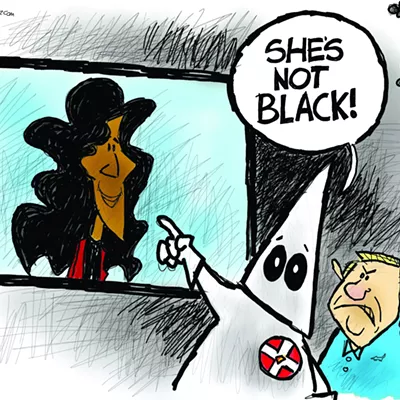The OSCE won't issue a final report for another six weeks, but its preliminary findings (available at www.osce.org/documents/odihr/2004/11/3779_en.pdf) are a litany of "questions of possible conflict of interest," "widespread ... allegations of electoral fraud and voter suppression," "significant delays ... (that) may restrict the right to vote" and "concerns ... regarding the secrecy of the vote." Not only that, but "it was not clear that poll workers had generally received sufficient training to perform their functions."
On the plus side, the election "proceeded in an orderly and peaceful manner," the OSCE says. And according to many news reports, America was awfully glad, above all else, that there was no untidiness with this election. Once John Kerry conceded, it seemed, concerns about voter suppression, intimidation and fraud could be safely ignored.
But there are at least two valid reasons why we should keep our eyes trained on Nov. 2. First, an analysis suggests that more Ohioans may have tried to vote for Kerry than for Bush, and couldn't--in which case, by rights, W. should be packing his bags and shredding his files, rather than plotting his second-term agenda. And besides--isn't this kind of thing horrible even if it didn't happen to tip the election this time?
Bush has, at the moment, won Ohio by 136,483 votes, but a number of considerations throw that lead into serious doubt. For one thing, that number will likely diminish when the state's approximately 155,000 provisional ballots are processed. Most of those who had to use provisional ballots probably were first-time voters whose names had not made it onto their precinct lists, observers say, and first-timers went 54-46 for Kerry in Ohio, according to exit polls.
Another 92,672 votes were discarded, according to Cleveland's The Plain Dealer, mostly due to now-familiar problems with punch-card ballots. Those punch-card machines are--surprise, surprise--predominantly used in urban areas that tend to vote Democratic. In Cuyahoga County--2-to-1 Kerry country--a voter reported misaligned holes and out-of-order pages on the punch ballots to Election Protection, a nonpartisan coalition of organizations led by People for the American Way Foundation, which was monitoring elections in select states, including Ohio.
But wait--wasn't the Help America Vote Act of 2002 supposed to help rid states of these punch-card machines? Why, yes--in fact, Ohio received $133 million from the federal government specifically to replace those old clunkers with new DRE and optical-scan machines. The state even contracted with venders. But then Secretary of State Kenneth Blackwell--a Republican--had a change of heart. The technology was not proven secure, he said.
"There should have been a lot of effort (put into), instead of talking about challengers, talking about getting enough machines and getting ready to handle the large turnout," says Dan Trevas, communications director for the Ohio Democratic Party.
The challengers Trevas has in mind were, of course, the Republicans deployed to polling places to make voters prove they weren't committing fraud. As it turns out, the Republican challengers were not especially disruptive, observers report. But they were one element in a broad pattern of alleged intimidation and deception. In Cuyahoga County, according to one Election Protection caller, black voters were asked to show ID, but white voters were not. In another area, some African-Americans reportedly were redirected to incorrect polling places across town, says Scott Britton, executive director of the League of Women Voters of Ohio.
Serious questions have also been raised about absentee ballots, which may have been withheld from those who requested them--a problem in Massachusetts as well. The single biggest election complaint in Massachusetts came from college students who sent for, but never received, absentee ballots from their home states, says David Harris, executive director of the Lawyers Committee for Civil Rights, in Boston.
Many of those who did get to the polls had to wait ages to get to a booth. There were reports of waiting times of 2 1/2 hours in Cleveland, five in Columbus and six in the college town of Gambier.
This was all officially blamed on extraordinarily high turnout, but many disagree. After all, turnout was actually lower than predicted by the Secretary of State's office, and the increase from 2000 worked out to just 64 additional voters per Ohio precinct. "Everybody saw it coming--the huge lines, the huge voter turnout," says Britton. "We're very concerned that county officials did not adequately prepare."
But Republican governor Bob Taft and Blackwell did prepare: They reduced the number of polling places, ensuring long lines. As noted above, the state had been anticipating the purchase of DRE machines, which are both more expensive and--at least in theory--quicker. That meant, according to Blackwell, that counties could make do with fewer machines without affecting the lines. The Republican-led Legislature helped encourage precinct consolidation by raising the maximum allowable number of registered voters per precinct. So, some counties merged their polling places, cutting as many as 48 percent in some cases.
At one Columbus site, the head poll worker was a half-hour late to open up, "and things went downhill from there," reported The Columbus Dispatch. Several other poll workers in the county overslept, according to the paper. The same thing happened in Cuyahoga County, where four polling places opened late, according to The Plain Dealer. Another poll worker was fired for showing up drunk.
Nobody in Columbus' Franklin County, including poll workers, could reach the elections-board office by phone--even when machines broke, which was frequent. For a 45-minute stretch at one site, all three voting machines were inoperative, according to the Dispatch, which added that half of the 100 people in line left without voting.
Here's the rub: An analysis shows that the precinct reductions disproportionately hurt Ohio's Democratic turnout.
Of Ohio's 88 counties, 20 suffered a significant reduction--shutting at least 20 percent (or at least 30) of their precincts. Most of those counties have Republicans serving as Board of Elections director, including the four biggest: Cuyahoga, Montgomery, Summit and Lucas.
Those 20 counties went heavily to Gore in 2000, 53 to 42 percent. The other 68 counties, which underwent little-to-no precinct consolidation, went exactly the opposite way in 2000: 53 to 42 percent to Bush.
In the 68 counties that kept their precinct count at or near 2000 levels, Kerry benefited from the high turnout, getting 24 percent more votes than Gore did in 2000, while Bush increased his total by only 17 percent.
But in the 20 squeezed counties, the opposite happened. Bush increased his vote total by 22 percent, and Kerry won just 19 percent more than Gore in 2000.
If the reduced number of precincts in those counties accounts for the difference, it cost Kerry about 45,000 votes. And who knows what might have happened had the state increased polling places in anticipation of the high turnout it knew was coming? And if the state had encouraged voting rather than threatened to challenge credentials? And if there had been no dirty tricks and intimidation? And if all had received their absentee ballots?
Would we be preparing for a Kerry presidency? We'll probably never know.










